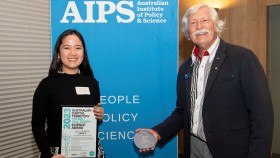Susanne von Caemmerer, a career in science from maths to plants
by Natalia Bateman Vargas
Susanne von Caemmerer arrived in Canberra from Europe at the age of 19 to study Honours in pure mathematics. While she was not intending to stay, she was trapped in the far-away land by a fascination for plant physiology.
Now she is recognised as a worldwide expert for using mathematics to represent the process by which plants convert sunlight, gases and water into sugars and oxygen – photosynthesis.
As a child she liked studying mathematics so later, as an undergraduate at ANU, she focused on pure maths and philosophy.
“My uncle, Professor Bernhard Neumann, who lived in Australia, was also a mathematician, and he was very supportive at the beginning of my career – and from there I was not going back to Europe,” she says.
“My aunt, Hanna Neumann, for whom a building at ANU is named, was a Professor in mathematics.”
Soon after finishing her undergraduate degree, von Caemmerer looked around for options to stay in Australia and took a job as a technical officer in plant science at the ANU Research School of Biology.
That excitement has never left me, after almost four decades of being part of ANU.
“I began working on stomata – the pores that plant cells have to interchange gases and water with the atmosphere – and after a while I was offered a PhD scholarship, so I took the challenge,” she says.
Her field of research is all about connections, flows and logic. The elegant equations that she has designed to represent photosynthesis have been extensively tested and utilised around the world. Those models are used in a range of scales from crop canopies to leaves, explaining biochemical processes and atmospheric gas exchanges.
“Throughout my PhD at ANU, I always felt that I was participating in cutting-edge research at the Research School of Biological Sciences, then part of the Institute of Advanced Sciences – that excitement has never left me, after almost four decades of being part of ANU,” she says.
After finishing her PhD, von Caemmerer decided to focus on plants that use the C4 photosynthesis pathway and she produced a photosynthesis model for plants such as maize and sorghum.
The models she has helped to construct are specifically designed to explain how leaves exchange gases and take and lose water from the atmosphere, and how CO2 intake changes with variations in temperature and other environmental parameters. They are needed in ecology, climate studies, physiology and biochemistry.
“The models have been incredibly useful. They permit people around the world to measure photosynthesis and use the models to compare how different plants function under different environments. The applications extend from the biochemistry of individual cells to a global atmospheric scale, which is very nice to see.”
Susanne von Caemmerer has received multiple awards, including the prestigious Charles F. Kettering award by the American Society of Plant Biologists in 2014 and this University’s highly regarded Peter Baume Award.
Music has been another constant in von Caemmerer’s life. She has played the violin and has been taking flute classes for several years.
“I have also sung in the choirs of the Canberra opera – my husband and I sang in Aida and learnt all the Italian by heart. It was lots of fun, we even had an elephant and a camel on stage!”
- This story first appeared in the ANU Reporter, Volume 49 No 3, Spring 2018








